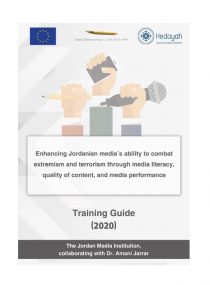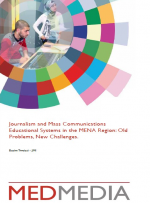Among JMI’s most noteworthy achievements in 2014 were expanding student admission and programs, focusing on academic quality and enhancing quantitative and qualitative training. The institute also achieved greater visibility, forging closer ties with Jordanian society and institutions. In addition, significant growth was recorded in many indicators, including financial resources.
First: Academic Field
The academic requirements were fulfilled for the graduation of the fifth intake of Journalism and New Media MA students. The sixth intake was admitted on new foundations: the launch of the thesis track alongside the comprehensive examination track. An integral study plan was designed for the thesis track, which was approved by the University of Jordan Council of Deans and went into effect at the beginning of the new academic year.
The introduction of the thesis track led to a quantitative expansion in admissions, with 45 students admitted at the beginning of the 2014/2015 academic year. Of these, 25 students enrolled for the comprehensive examination track and 20 for the thesis track. The institute achieved this quantitative expansion, around 20% higher than the average in previous years, while staying within the 50-student ceiling set by the Higher Education Accreditation Commission, to ensure that it could sustain and develop quality standards.
In 2014, implementation began of the academic quality plan, which was designed to develop admission principles and procedures and improve the level of students admitted to the institute. The plan also sought to regulate academic processes in line with quality standards, linking the educational process to current events and documenting students’ academic status.
In 2014, a series of parallel activities were organized for students, including 22 lectures and seminars in the JMI premises, seven training programs and courses and 14 activities outside the institute. Also, 24 students of the fifth intake went to Norway on a cultural exchange trip, eight participated in the annual Media and Digital Literacy Academy program in Lebanon and one took part in the annual program of the Salzburg Academy on Media and Global Change in Austria.
Second: Projects and Research
In the summer of 2014, the institute launched the research and publications program. Three academic studies on media were completed and a number of books were published, including "Al-Mandhur" and a guidebook on "Press Coverage of Human Rights Issues."
JMI carried out a number of programs and projects in 2014: the Jordanian Media Credibility Monitor (AKEED); “Detecting Human Rights Violations in Jordanian Media Outlets” in collaboration with the Australian Embassy and Australian Aid; “Expanding Public Dialogue on Human Rights Issues through Media” with Canada’s Journalists for Human Rights; “Monitoring Gender Issues in Jordanian Media Outlets” in collaboration with the Dutch Embassy; “Media Reforms in the MENA Region (MedMedia); and a cooperation program with the Swedish Postcode Lottery Culture Foundation and Reporters Without Borders Sweden office.
The cooperation program with the Norwegian Institute of Journalism continued and witnessed important achievements, such as organizing and supporting scientific conferences – the first in the history of the institute. These included the first Jordanian conference for radios, titled “The Role of Radios in Development and Democratization (February 2014) and a conference on “Syrian Refugees in Jordan: Question of Society and Media” (December 2014). Four training programs were organized for students, in addition to a trip to Norway as part of the cooperation program.
Third: Training
In 2014, JMI collaborated with 13 local, regional and international institutions to conduct 37 training programs, courses and workshops attended by 671 Jordanian and Arab trainees.
This worked out to an average of 3.16 programs or courses and 55.9 trainees per month.
Jordanian journalists constituted the majority of beneficiaries at 40%, followed by the staff of local organizations at 16% and Arab trainees at 11.9%.
Fourth: Institutional Framework
The JMI management sought to develop institutional performance by implementing a new strategic plan, which entailed developing internal legislation (administrative and financial regulations), the institute’s organizational structure and an electronic archiving and documentation system.
The institute fostered its local, regional and international relations and status by signing eight agreements and memorandums of understanding with the King Abdullah II Fund for Development, the Higher Population Council, the General Directorate of the Gendarmerie, Birzeit University, Al-Quds University, the UAE newspaper Al Watan, Brighton Center for IT Consultancy and Training and the UAE-based International Institute for Planning and Administrative Development.
The institute’s media visibility reached its highest level in 2014 compared to previous years, reflecting an increase in JMI activities. News stories published on the JMI website rose by 16% from the previous year and by 300% from 2012, while the number of stories published about the institute in Jordanian and Arab media increased by around 98% from the previous year. Media outlets published 841 news items about the institute in 2014, compared with 443 in 2013.
Fifth: Resources and Sustainability
The JMI’s annual income in 2014 registered a growth rate of around 90% compared with 2013 and 30% compared with the average of the previous two years. It was the first year in the history of the institute where a deficit was not registered.
Revenues from training accounted for around 18% of the total income, a 98% growth rate compared with 2013, whereas income from tuition fees was 110% higher than the previous year, constituting 8% of the total resources. The revenue from scholarships offered by donors maintained the same level as the previous year, accounting for 16%, while project revenues comprised 33% of the total income.
Revenues exceeded expenditures by around 7%. The MA program had the biggest share of expenditure at 31%, followed by administrative costs, which were 12% lower than the previous year.



